Industrial design student showing sustainable leather tanning in Milan
Master’s student Ioana Stefanescu is in Milan, Italy showing the world her new designs using a much more sustainable way of tanning leather. The timing is not random: it’s Fashion Week in Milan and therefore many representatives of big brands will be visiting. Ioana has learned how the fashion industry still uses a very polluting technique of processing leather and she is dedicated and inspired to designing with natural and non-toxic processing methods.
Together with a manager of the Wearable Senses Lab, Holly Krueger, Ioana attended the Craft The Leather Consortium last year in May 2023 and now Ioana is showing her resulting capsule collection at the internationally renowned Lineapelle trade fair in Milan. The participation of the Industrial Design department will be a one-off project organizers demanded: departments can only send a participant once.
“In total, we were eight students from around the world meeting for the workshop in San Miniato, Italy. We learned a lot about veg-tanned skins and were then challenged to create three design pieces from two skins they provided. As for my theme, I chose to represent the history of San Miniato.”
Polluted water
“Leather is basically produced in four steps: first we have the skins as a waste product of the meat industry, then the tanning happens to make it smooth and clean, then the skins are dyed, then they are processed to become bags or belts for example.” The process of tanning traditionally concerns a lot of chemicals. The so-called ‘chrome-tan’ is where metals are used to prepare the skin to be dyed.
Ioana: “In this project, we learned an environmentally friendly way: veg-tanning. This is done with water and the water may be purified after. With chrome-tanning the water becomes toxic while veg-tanning allows for the regular water purification process.”
“The fast-fashion industry currently uses chrome-tanning, as do many luxurious brands. This has to do with the fact that chrome-tanning takes two days and veg-tanning two months. Time is money, especially in the fast-fashion industry.”
Leftovers as a fertilizer
“Some expensive brands are trying to change to veg-tanning,” Ioana says. “We were told about Gucci and Chanel for example. But even then, they still dyed their leather with acrylic dye which makes the end product not biodegradable anymore.” In the workshop, they also learned an alternative to acrylic dye. Ioana really hopes the industry shifts to a more circular production of leather.
She also has ideas about what to do with the small left-over pieces that stay after the cutting of the necessary shapes: “I found out you can make those into a fertilizer that you can use on the land. So what you take from the world can also come back to it.”
‘Vegan leather’ is misleading
During the workshop, she learned some quite unexpected facts about ‘vegan leather’ which is often promoted as the more durable alternative to real leather. “These days you see for example ‘cactus leather’ or ‘mushroom leather’. Many of the ‘vegan’ leathers currently available for consumers are made from fossil-fuel, that can consist of 70 percent to 98 percent plastic [1]( Spinnewijn, O. , 2022). Yes, I was shocked too."
"People who are concerned about the environment are misinformed and often buy these vegan leather alternatives as they want to do something good. In a lot of cases, animal leather is currently still the best in terms of sustainability when it comes to production and manufacturing, of course only if it is indeed the waste product of the meat industry. Even if the real leather is chrome-tanned it’s still less burdensome than the fake leather, go figure…[2] (Carcione F., et.al. , 2023). But I want to go for the circular option which veg-tanning is part of.”
The veg-tanning can be done in three ways: with mimosa, walnuts or chestnuts. “They extract oil and use that to tan it. That’s why it turns brown unless mimosa is used, then it’s more white. The options for dyeing the leather naturally are super cool too: you can ‘draw’ on the leather with for example milk or egg white and then once it has dried, use alcohol-based dye over it. Then if you for example made a line with the milk, it stays.”
Lucky
Ioana feels so happy and lucky to be chosen and this is clearly visible during the interview. “I’m just so passionate about working with clothes and wearable materials which was noticed within the Wearables Squad. Holly supported me a lot in the process with her knowledge as a fashion designer, and of course I wouldn’t have been able to be part of this experience if it weren’t for professor Kristina Andersen that noticed my passion in the field of wearables.
The ID student is mostly excited to network and connect with people who come to check out the designs of the project. “I hope to show as many companies as possible this sustainable way of treating and producing tanned leather, and of course develop the possibility to work with them. During Fashion Week we have very good chances with big brands that are there already.”
From Milan to Hong Kong
From February 20 until 22 the leather creations can be seen in Milan after which they will be sent to Hong Kong for another exhibition. If Ioana manages to get the most votes, she may win a prize that could also help her in the future as she hopes to pursue a career in the field of sustainable materials. “I always wanted to do something in the wearables industry but also apply my ID knowledge, like how to laser cut or 3D print, and I wanted to do something unique. This project gave me all that. I will continue working on this, even after the show finishes.”
Ioana about her final pieces: “I hope to have embodied the history and culture of San Miniato through three pieces that form an ensemble. Together they signify a journey of becoming, where spirituality and human experience merge. The pieces are inspired by the organic patterns from the local flora and fauna, representing blooming flowers through the arms growing out of the cape, and emphasizing an air of royalty, inspired by Santa Chiara’s museum, through a reinterpretation of the headdress.”
Ioana laser cut her design and refrained from using thread. “To sew leather you need very strong thread which contains plastic. That’s not something I wanted as then it’s not a circular product anymore. Therefore I made this mechanism that ‘hooks’ and therefore doesn’t require thread. The face crown I could mold with water and keep like this purely because it was veg-tanned. By making it wet again, you can model it in any other way you desire."
[1] Spinnewijn, O. (2022). Innovative Leather Alternatives: A Short-Lived Trend or the Future of Fashion?. https://studenttheses.uu.nl/handle/20.500.12932/41443
[2] Carcione, F., Defeo, G. A., Galli, I., Bartalini, S., & Mazzotti, D. (2023). Material Circularity: A Novel Method for Biobased Carbon Quantification of Leather, Artificial Leather, and Trendy Alternatives. Coatings, 13(5), 892. https://www.mdpi.com/2079-6412/13/5/892
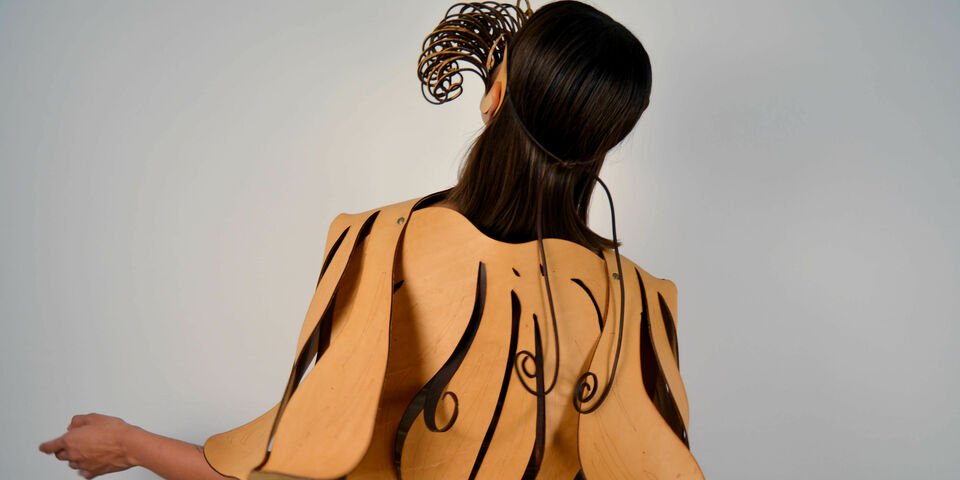

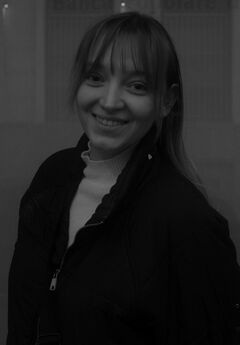
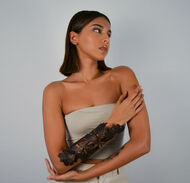
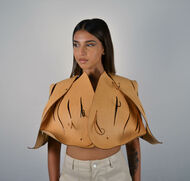
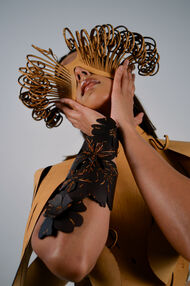
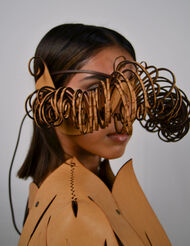
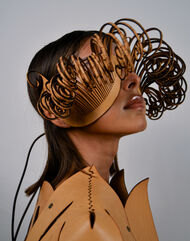

Discussion